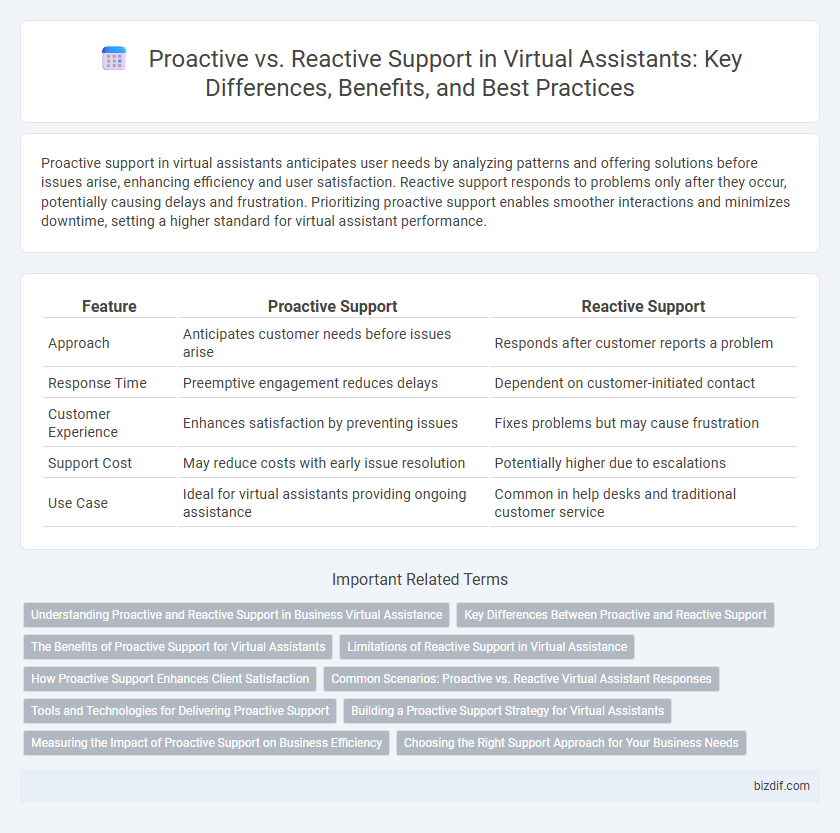Proactive support in virtual assistants anticipates user needs by analyzing patterns and offering solutions before issues arise, enhancing efficiency and user satisfaction. Reactive support responds to problems only after they occur, potentially causing delays and frustration. Prioritizing proactive support enables smoother interactions and minimizes downtime, setting a higher standard for virtual assistant performance.
Table of Comparison
| Feature | Proactive Support | Reactive Support |
|---|---|---|
| Approach | Anticipates customer needs before issues arise | Responds after customer reports a problem |
| Response Time | Preemptive engagement reduces delays | Dependent on customer-initiated contact |
| Customer Experience | Enhances satisfaction by preventing issues | Fixes problems but may cause frustration |
| Support Cost | May reduce costs with early issue resolution | Potentially higher due to escalations |
| Use Case | Ideal for virtual assistants providing ongoing assistance | Common in help desks and traditional customer service |
Understanding Proactive and Reactive Support in Business Virtual Assistance
Proactive support in business virtual assistance involves anticipating customer needs and resolving issues before they arise, enhancing customer satisfaction and operational efficiency. Reactive support focuses on responding to customer inquiries and problems as they occur, emphasizing timely and accurate solutions. Implementing a balanced approach between proactive monitoring and reactive problem-solving maximizes the effectiveness of virtual assistant services in driving customer engagement and loyalty.
Key Differences Between Proactive and Reactive Support
Proactive support involves anticipating customer issues and addressing them before they escalate, leveraging AI-driven analytics and real-time monitoring to enhance user experience and reduce downtime. Reactive support responds to problems only after they occur, focusing on troubleshooting and resolving existing issues through helpdesk interventions or live chat assistance. Key differences include timing--proactive acts preventively, while reactive acts retrospectively--and impact, where proactive support improves satisfaction and loyalty by minimizing disruptions, whereas reactive support prioritizes damage control and quick resolution.
The Benefits of Proactive Support for Virtual Assistants
Proactive support in virtual assistants enhances user satisfaction by anticipating needs and resolving issues before they arise, resulting in fewer interruptions and smoother interactions. This approach leverages AI-powered analytics and real-time data to deliver personalized assistance, improving efficiency and reducing operational costs. Businesses adopting proactive support report higher customer retention rates and increased engagement due to the seamless, intuitive user experiences provided by advanced virtual assistant technologies.
Limitations of Reactive Support in Virtual Assistance
Reactive support in virtual assistance often struggles with delayed issue resolution, as it only addresses problems after they arise, leading to decreased customer satisfaction. This approach lacks the ability to anticipate user needs, resulting in missed opportunities for improving user experience through proactive engagement. Consequently, virtual assistants relying solely on reactive support may face increased operational costs and reduced efficiency compared to those incorporating proactive strategies.
How Proactive Support Enhances Client Satisfaction
Proactive support anticipates client needs by identifying and resolving issues before they escalate, leading to faster problem resolution and reduced downtime. Virtual assistants leveraging AI can monitor system performance and user behavior to deliver timely notifications and personalized solutions. This approach boosts client satisfaction by providing seamless, uninterrupted experiences and fostering trust through consistent, attentive service.
Common Scenarios: Proactive vs. Reactive Virtual Assistant Responses
Proactive virtual assistants anticipate user needs by offering timely suggestions or reminders, such as notifying customers about upcoming bill payments or potential service disruptions before they occur. Reactive virtual assistants respond only after receiving direct user input, addressing queries like troubleshooting technical issues or answering FAQs on demand. In common scenarios, proactive support enhances user experience through anticipation and prevention, while reactive support delivers precise solutions after problems arise.
Tools and Technologies for Delivering Proactive Support
Proactive support utilizes AI-driven chatbots, predictive analytics, and machine learning algorithms to identify and resolve customer issues before they escalate. Tools such as real-time monitoring systems, automated alerts, and customer behavior analysis platforms enable virtual assistants to deliver timely, personalized assistance. These technologies reduce response times and enhance user satisfaction by preventing problems rather than merely reacting to them.
Building a Proactive Support Strategy for Virtual Assistants
Building a proactive support strategy for virtual assistants involves leveraging real-time data analytics and AI-driven insights to anticipate user needs and resolve issues before they escalate. Implementing continuous monitoring systems and automated alert mechanisms enables virtual assistants to deliver personalized, context-aware responses that improve customer satisfaction and reduce support costs. Emphasizing proactive communication through predictive modeling and user behavior analysis transforms virtual assistants into intuitive problem-solvers rather than mere reactive responders.
Measuring the Impact of Proactive Support on Business Efficiency
Proactive support in virtual assistants significantly enhances business efficiency by reducing customer wait times and minimizing issue escalation, leading to faster resolution rates. Metrics such as decreased average handling time (AHT), increased first-contact resolution (FCR), and improved customer satisfaction scores (CSAT) demonstrate the tangible benefits of anticipatory assistance. Data analysis reveals businesses employing proactive virtual assistant support experience lower operational costs and higher retention rates compared to reactive support models.
Choosing the Right Support Approach for Your Business Needs
Proactive support leverages AI-driven virtual assistants to identify and resolve issues before they impact customers, enhancing user satisfaction and reducing service costs. Reactive support relies on addressing problems as they arise, providing tailored solutions based on direct customer interactions but often resulting in longer resolution times. Selecting the right approach depends on your business's scale, customer expectations, and resource availability, with many companies benefiting from a hybrid model that combines proactive monitoring and reactive problem-solving.
Proactive support vs Reactive support Infographic

 bizdif.com
bizdif.com